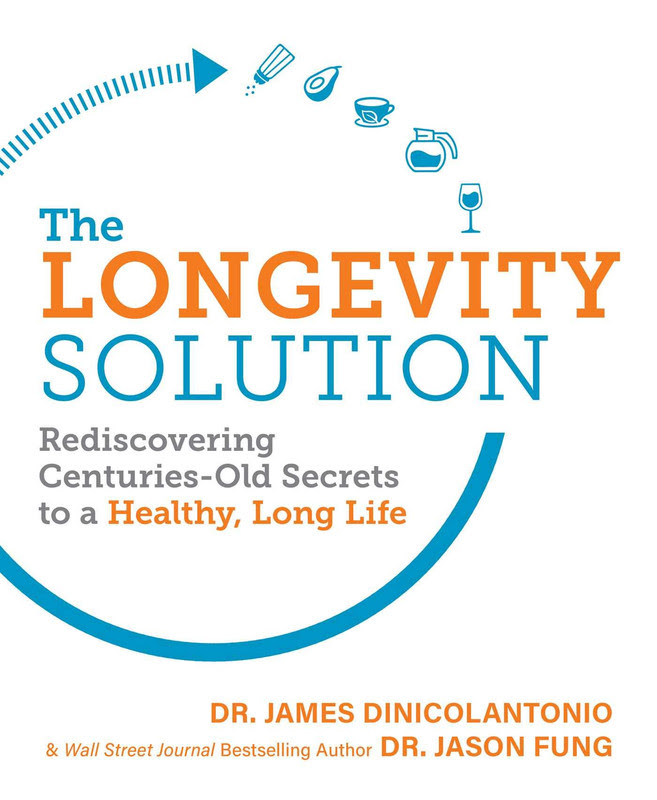
I have been reading the new book just released by Jason Fung, The Longevity Solution. Jason is the kidney specialist from Toronto I have mentioned to many of you that have blood sugar problems because he has been reversing diabetes through fasting. Now he has written a book with Dr. DiNicolantonio expanding the amazing results on diabetes to the much bigger challenge of aging.

I have been following anti-aging research for about 15 years now out of simple interest. To this point the most consistently reliable method to lengthen lifespan has been strict calorie restriction. Over the last few years a lot of tantalizing research has been done involving one of the key metabolic consequences of fasting, autophagy. Autophagy is the body’s process for removing the broken stuff that results from the process of living. Failure to remove this broken garbage stuff is one of the prime causes of disease as we age. Autophagy is triggered by fasting or severe calorie restriction.
Fundamental physiology describes two basic states for a living body – anabolism and catabolism. Anabolism is the growth and repair state within a body. It is when the body constructs complex structures from simple ones. A place where you may have heard of this is when athletes use anabolic steroids to build huge muscles. Anabolism is the state that we think of when we think of youth. Catabolism is the opposite of anabolism. It is when the body breaks complex structures down into simple pieces to either recycle them or dispose of them. Muscle wasting in disease is an example of this.

The field of anti-aging has looked at aging as a lack of the youthful anabolic processes in the body forever. One of the key drivers of anabolic activity is Growth Hormone, something which decreases in concentration as we age. For a long time now much of anti-aging science has been centered on increasing growth hormone so we can build stronger muscles and bones like we had in our youth. Thousands of medical clinics have been opened to fight aging through the use of hormones to turn back the clock. While they are able to get superficial results for a while, the goal of actually living longer has not materialized.
The reason why the fight against aging has failed for so long was revealed in this book, The Longevity Solution. For me this was a paradigm shift. I have had all the pieces right in front of me, but I just didn’t put this last piece in place till now. I have even mentioned the essential element in previous newsletters – that the diseases of modern society are all diseases of excess – but I didn’t connect that what that really means is that they are all diseases of anabolism. The diseases that kill most all of us are the consequence of the body trying to stay young. Cancer is all about excess cell growth. Heart disease is all about too much cell growth in the linings of the blood vessels. Diabetes II is all about the resistance the body forms when it is asked to store too much fat. The many diseases that result from toxic levels of stuff in the body are the result of the body always running the growth and repair programs instead of the breakdown and eliminate programs. Even dementia is about the accumulation of misfolded proteins in the brain – a lack of cleanup of the brain. We are no longer killed off primarily by infectious diseases and injuries like we were through most of history.

Wow, what a change of viewpoint! Everything science has been focusing on to stop aging has actually been making us live shorter lives. This has actually shown up in many studies. Interventions designed to help people live longer have been shown to actually create shorter life spans. The only thing that has worked at all has been in populations that have chosen to restrict either gross calories, or proteins. This is the key insight to understanding longevity.
Catabolism is the key to longevity. We have to take out the trash and recycle the bits and pieces of the good stuff in order to be healthy. Old dysfunctional parts of our cells have to be removed so they can be replaced with shiny new parts. If we don’t eliminate the broken parts, we limp along getting worse and worse until the cells die. We get old and decrepit. We keep on trying to build on top of the garbage and the result is the poor tissue quality we see in aging. So what controls catabolism?

The answer is disarmingly simple – food. Throughout human history food has been a key struggle for survival. Consequently mother nature designed us to “make hay while the sun shines.” In physiology terms what that means is that we build (anabolic) whenever food is available and do our cleanup work (catabolic) when it is not available. We have special regulators that sense when food is available for use in the body that trigger the growth and repair pathways. The big regulator being studied a lot right now is called mTOR. It senses cellular energy, oxygen, and nutrient levels and upregulates protein synthesis through growth factors like IGF1 & 2. What mTOR looks for is protein coming into the system, particularly the amino acid leucine. Another nutrient sensor that regulates growth is good old insulin, which responds to carbohydrates entering the system.

So, when we eat protein or carbohydrates, our system goes into anabolic growth and repair mode and shuts down cataboilc clean-out and recycle mode. When we are young we want to be in anabolic growth and repair mode. Nature supports this long enough for us to reproduce. The younger you are the more growth and repair you need. But all this time the garbage is building up and eventually it catches up with us. The growth and repair turns into degenerative disease. Mother nature is fine with this because all she wants is for us to reproduce, after which we become unnecessary and expendable. But what if we don’t want to be expended?

Have you noticed how the stuff you used to be able to get away with when you were young, you can’t get away with anymore? That is right, we can’t go back. Those days are over. Age 21 is not coming back. Trying to live like we are 21 is not only not going to work, but will actually kill us by creating disease instead of health. What worked for us then won’t work now. We need radically different strategies to deal with an older body. Got it?
Basically the average American does a feeding frenzy until he/she hits middle age. They are able to eat all sorts of crap and get away with it. Somewhere along the line that stops working. Not only do you have to stop eating crap, but you have to stop eating period. You have to stimulate the catabolic cleanup crew to show up and do their job, and that means no intake of proteins or carbohydrates that turn on the anabolic pathways and turn off the catabolic pathways. From the time of your last meal it takes about 8 hours for the anabolic surge to slow down and surface level catabolism to start. Surface level means liver cleanup processes start. It takes longer to stimulate cleanup in other tissues – different times for each tissue. This understanding is the reasoning behind intermittent fasting, in which you confine your eating to an 8 hour window during the day. This will finish processing in another 8 hours, leaving the last 8 hours of the day for the liver to switch into catabolism and start to clean up its act.

But once we reach senior status, 8 hours is not enough. We need to spend a lot more time without eating any carbs or proteins to allow the body to start cleaning out the abuses of our long life. If we did regular fasting throughout our life like many cultures do, this wouldn’t be necessary, but we didn’t. Although even if we did, the amount of air, water, environmental, and food pollution today in America probably means we need to be doing clean-out from the day we are born. We can’t live a long healthy life if our cells are filled with garbage and poisons. Trying to be young by pumping up growth and repair only kills us faster. We have to take a different path. Purification is the order of the day if we want to live long and prosper. What that looks like will be the subject for another newsletter.
